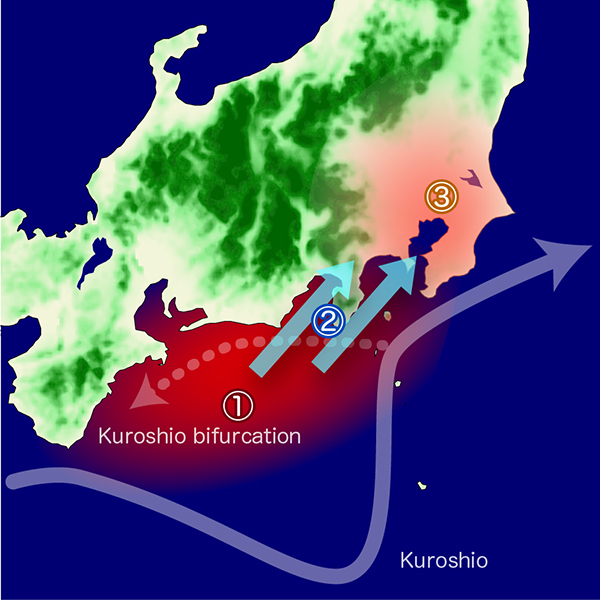Forty million people living in the Kanto region of Japan, which includes Tokyo, may be able to blame a meandering ocean current for increasing hot and humid summers, according to an analysis conducted by an international team of researchers. The Kuroshio Current flows north, bringing warm water from the tropics to Japan's southern coast. Since 2017, however, it has meandered off its traditional path, turning south before continuing north again. Now, scientists have found that the "large meander" is responsible for the uptick in humidity and temperature.
The researchers, from Tohoku University in Japan and the University of Hawaii in the United States, published their results online on Feb. 1 in the Journal of Climate, a journal of the American Meteorological Society.
"In recent years, it has become clear that the ocean influences climate," said first author Shusaku Sugimoto, associate professor of geophysics in the Graduate School of Science at Tohoku University. "Our study shows that the Kuroshio influences the regional climate - especially through the greenhouse effect of water vapor, contributing to significantly warmer temperatures."
The researchers used satellite data from the National Aeronautics and Space Administration (NASA), as well as data from the Automated Meteorological Data Acquisition System stations operated by the Japan Meteorological Agency, to examine 18 summers since 2003.
The last large meander occurred for a year from 2004 to 2005 before starting again in 2017. Controlling for other climatic events, such as storms, and considering global warming trends, the researchers assessed the differences in summers during typical summers and summers during which Kuroshio's path took a large meander.

ⒸTohoku University
"We found that the surface air temperature in the Kanto district increased by about 0.6 degrees Celsius as a result of the Kuroshio large meander," Sugimoto said. "As a mechanism of the warming, we discovered that the Kuroshio large meander increases evaporation and the water vapor flowing into the Kanto region, leading to a hot summer through a local greenhouse effect."
Using Thom's index, a widely used standard of human discomfort based on temperature and humidity, the team found large meander summers resulted in 13.1 days of most people experiencing discomfort. That's a 160% increase over the 8.1 discomfort days of non-large meander summers.
"This is a result that affects the lives of many people," Sugimoto said. "Our analysis showed the Kuroshio path state is responsible for the climatic comfort of living in Tokyo, Japan, and our approach is also applicable in other coastal cities worldwide."
The researchers plan to apply their work to improve both climate and local weather forecasts, according to Sugimoto, so that people may be better prepared to handle higher temperatures and more humidity.
"The results of this research are expected to contribute to the reduction of heatstroke risk and the formulation of climate change adaptation plans," Sugimoto said. "This finding detects the influence of the ocean on regional climate, and we hope that it will contribute to the improvement of weather and seasonal forecasts."
- Publication Details:
Title: Local atmospheric response to the Kuroshio large meander path in summer and its remote influence on the climate of Japan
Authors: Shusaku Sugitomo, Bo Qiu, and Niklas Schneider
Journal: Journal of Climate






